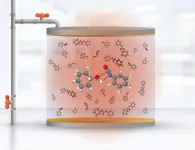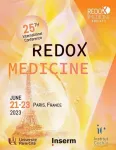(Press-News.org) To enjoy the scent of morning coffee and freshly baked cookies or to perceive the warning smell of something burning, the brain needs two types of cells, neurons and astrocytes, to work closely with each other. Research has shown a great deal of the changes that occur in neurons during olfactory, or smell, perception, but what are the astrocyte responses and how they contribute to the sensory experience remains unclear.
Researchers at Baylor College of Medicine and collaborating institutions report in the journal Science the responses of astrocytes to olfactory stimulation, revealing a new mechanism that is required to maintain astrocyte-neuron communication and process olfactory sensation.
“Previous studies have shown that under natural conditions in a living animal, olfactory stimulation of the brain activates neurons first, which changes the genes these neurons express to be able to mediate the olfactory sensation,” said first author Dr. Debosmita Sardar, a postdoctoral associate in Dr. Benjamin Deneen’s lab at Baylor. “In this study, we investigated what occurred to astrocytes following neural activity during olfactory stimulation and uncovered changes that had not been described before.”
Olfactory stimulation triggered an increase of serotonin transporter Slc22a3 on the astrocytes, which mediated serotonin transport into the cells. “We followed serotonin inside the astrocytes and were surprised to discover that it traveled to the cell nucleus, where it bound to histones, proteins attached to the DNA that help regulate astrocyte gene expression,” Sardar said. “Serotonin bound to DNA acted as a switch, which controlled gene expression.”
Interestingly, serotonin regulates the expression of astrocyte genes involved in the production of the neurotransmitter GABA, which then feeds back to neurons regulating the neural circuit fundamental to sensory perception.
“We showed that losing transporter Slc22a3 in astrocytes reduced serotonin levels in the cells and led to alterations in serotonin-bound DNA,” Sardar said. “In turn, this reduced the expression of genes involved in the synthesis of GABA and decreased astrocytic GABA release, which disturbed the neural circuits of olfactory sensation.”
Serotonin is well known for its contribution to normal brain function as well as being involved in addiction and depression. “Here we discovered a new function of serotonin in astrocytes. Serotonin triggers changes in astrocyte gene expression patterns, turning astrocytes into a hub of olfactory sensation processing,” Sardar said.
“This project has uncovered novel aspects of astrocyte function,” said Deneen, professor and Dr. Russell J. and Marian K. Blattner Chair in the Department of Neurosurgery and director of the Center for Cancer Neuroscience at Baylor. He also is the corresponding author of the work. “We are learning that astrocytes are very plastic, just as neurons are, meaning that astrocytes can change their characteristics and functions in response to environmental stimuli. They listen to neurons and respond, and their two-way communication is at the core of sensory processing and ultimately, animal behavior.”
Other contributors to this work include Yi-Ting Cheng, Junsung Woo, Dong-Joo Choi, Zhung-Fu Lee, Wookbong Kwon, Hsiao-Chi Chen, Brittney Lozzi, Alexis Cervantes, Kavitha Rajendran, Teng-Wei Huang, Antrix Jain, Benjamin Arenkiel and Ian Maze. The authors are affiliated with one or more of the following institutions: Baylor College of Medicine, Jan and Dan Duncan Neurological Research Institute at Texas Children’s Hospital and Icahn School of Medicine at Mount Sinai.
This work was supported by grants from the NIH (NINDS R01-NS071153, R01-AG071687, NIMH R01-MH116900, NIDCD 1K99-DC019668). Further support was provided by Dan L Duncan Comprehensive Cancer Center NIH award (P30 CA125123), CPRIT Core Facility Award (RP210227), NIH High End Instrument award (S10OD026804) and National Institutes of Health Cancer Center Grant (P30 CA125123).
###
END
Astrocyte processing of serotonin regulates olfactory perception
2023-06-15
ELSE PRESS RELEASES FROM THIS DATE:
Close up on aging reveals how different cell types in the body age at different pace
2023-06-15
As the body ages, organ function progressively declines and the risk for a wide range of diseases, including cardiovascular disease, cancer and neurodegenerative diseases, increases. Understanding how the body ages is an intense area of research as it will potentially illuminate ways to promote healthy aging.
Researchers at Baylor College of Medicine, Chan Zuckerberg Biohub San Francisco, Genentech, Inc. and collaborating institutions are breaking a path in that direction. They report in the journal Science, the first Aging Fly Cell Atlas (AFCA), ...
A new path for quantum physics to control chemical reactions
2023-06-15
Controlling chemical reactions to generate new products is one of the biggest challenges in chemistry. Developments in this area impact industry, for example, by reducing the waste generated in the manufacture of construction materials or by improving the production of catalysts to accelerate chemical reactions.
For this reason, in the field of polariton chemistry - which uses tools of chemistry and quantum optics - in the last ten years different laboratories around the world have developed experiments in optical cavities to manipulate the chemical reactivity of molecules at room temperature, ...
Light Pollution Special Issue
2023-06-15
Light pollution is increasing around the globe, both in its intensity and geographic extent. Researchers are documenting its impact on ecosystems, human health, and culture, while warning that the wasted light has financial costs, environmental impacts, and is responsible for substantial greenhouse gas emissions. In a special issue of Science, five papers discuss the growing adverse impacts of light pollution, along with the regulatory and technological solutions that could help mitigate its effects.
Artificial ...
Aging fly atlas reveals cellular-level view of aging over the life of a model organism
2023-06-15
Tzu-Chiao Lu, Maria Brbic and colleagues have completed the Aging Fly Cell Atlas, a single-nucleus transcriptome map of the Drosophila melanogaster fly as it ages. Aging is known to be a risk factor for many diseases across many animals including humans, but understanding how the process affects cell composition and different cell types is still mostly unknown, making the new atlas a valuable reference in further studies. Lu et al. used single-nucleus RNA sequencing to generate the Fly Cell Atlas that profiles ...
Massive eruption of Ontong Java Plateau is younger than previously thought
2023-06-15
New high-precision argon isotope dating of the Ontong Java Plateau indicates that it is 10 million years younger than previously thought, according to Peter Davidson and colleagues. The Ontong Java Plateau is part of a massive underwater volcanic eruption – possibly the largest in Earth’s history – that took place in the Cretaceous Period in the equatorial western Pacific Ocean. This huge igneous emplacement has been proposed as the cause of Ocean Anoxic Event (OAE) 1a – a short period of severely reduced oxygen in the ocean - but the new dates for the eruption suggest it happened after OAE 1a. Some researchers ...
Cleaner air with a cold catalytic converter
2023-06-15
The so-called three-way catalytic converter in the exhaust system of a car consists of expensive materials and only works correctly when the exhaust gases have a temperature that is several hundred degrees Celsius.
As a result, when you start your car, or when you drive a hybrid car in which the petrol engine and electric motor alternate between driving the powertrain, the gases leaving the exhaust still contain toxic carbon monoxide. In a new Science article, scientists led by Emiel Hensen now show that by modifying the carrier material of the catalyst, it is possible to almost completely convert toxic carbon monoxide into carbon dioxide gas even at room temperature.
Noble ...
Illusions are in the eye, not the mind
2023-06-15
Numerous visual illusions are caused by limits in the way our eyes and visual neurones work – rather than more complex psychological processes, new research shows.
Researchers examined illusions in which an object’s surroundings affect the way we see its colour or pattern.
Scientists and philosophers have long debated whether these illusions are caused by neural processing in the eye and low-level visual centres in the brain, or involve higher-level mental processes such as context and prior knowledge.
In the new study Dr Jolyon Troscianko, from the University of Exeter, co-developed a model that suggests simple limits to neural responses – not deeper ...
If art is how we express our humanity, where does AI fit in?
2023-06-15
The rapid advance of artificial intelligence has generated a lot of buzz, with some predicting it will lead to an idyllic utopia and others warning it will bring the end of humanity. But speculation about where AI technology is going, while important, can also drown out important conversations about how we should be handling the AI technologies available today.
One such technology is generative AI, which can create content including text, images, audio, and video. Popular generative AIs like the chatbot ...
NCCN convenes policy summit assessing impact of geography on cancer outcomes, examining rural and urban divide
2023-06-15
WASHINGTON, D.C. [June 15, 2023] — Today, the National Comprehensive Cancer Network® (NCCN®)—an alliance of leading cancer centers—convened a policy summit to examine how geography impacts cancer outcomes.
NCCN Chief Executive Officer, Robert W. Carlson, MD, opened the event with a focus on equity.
“NCCN’s work is guided by the idea that where you live should not impact whether you live,” said Dr. Carlson. “NCCN Guidelines are one free resource to make sure everyone, everywhere, has access to cancer care based on the latest evidence ...
Shaping the future of medicine: Redox Science takes center stage at the International Conference of Redox Medicine Society in Paris
2023-06-15
Paris is set to host the highly anticipated 25th International Conference of the Redox Medicine Society, where global leaders and experts from the field will converge to unveil groundbreaking advancements and shed light on the future of Redox Medicine. Taking place from June 21 to June 23, the conference will feature over 61 dynamic communications, including major presentations, short talks, and poster sessions, showcasing the latest research and discoveries in the field of redox reactions, oxidative stress, and their profound ...




